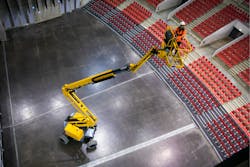Interview with Haulotte’s Paul Jensen: Going Electric
RER: What impact has COVID-19 had on your business and what do you expect going forward?
Jensen: Like the rest of the industry, we came home from ConExpo and stepped off the plane into a completely different world from the one we left on our way to Las Vegas. We had completed some recent IT and communication upgrades that made it simple to shift to a remote working model to keep in touch with our customers and support them remotely with technical advice and spare parts order fulfillment. We’ve been lucky to keep everyone safe and healthy and have been able to reopen our offices with a few safety modifications.
While we do see some customers postponing Capex spending for now, we also see an increased interest in our trailer booms. The lightweight booms are being shipped as quickly as they can be produced at our Ohio production facility. The big challenge now that we share with most of the construction equipment industry during this recovery period is, working with suppliers to get parts to the production line as quickly as possible.
What have been the latest developments in your company’s product line in the past year?
Haulotte made a bold statement in the industry promising to replace internal combustion engines with alternative energy sources in a step-by-step process with the introduction of the HA61 LE electric articulating boom. Expect to see those next steps coming soon as Haulotte gets ready to announce new, innovative MEWP power solutions.
What have been the most important recent trends in aerial product development and what trends look most important in the near future?
Stepping away from combustion engines has been a big trend in MEWP and many other equipment sectors as well. As electric power becomes more popular, equipment owners suddenly have to become expert caretakers of their newest big investment, batteries. Haulotte’s new Activ’Energy Management system takes the pressure off equipment owners and technicians by keeping a close eye on battery health and user charging habits. The new system recommends best practices, sends alerts when maintenance is needed, and can even automatically fill the electrolyte in each cell when needed. Equipment owners can feel confident that their battery investment is safe even if rental customers don’t have the best battery care habits.
Now that new ANSI standards have become a reality, how would you assess the impact they are having so far? How are customers adapting to newer machines with load-sensing technology, terrain-sensing, indoor/outdoor restrictions and so on?
We have seen a real positive acceptance of the new standards. I think the industry understands that the new changes to the equipment are all focused on making sure machines were compliant with many of those requirements well in advance of the implementation date, creating a smoother transition.
What level of demand are you seeing for electric MEWPs, hybrids, alternative fuels?
We have been surprised at how well the new Pulseo Generation articulating boom has been received within the worldwide market. Interest and sales have exceeded our forecasts and we look forward to continuing to grow the Pulseo range of equipment.
How do you see adoption of telematics systems changing the rental industry?
From the OEM perspective, telematics data is going to make much better machines that are optimized to exactly how customers use them. Manufacturers do a lot of research into how machines are used and interview customers about their habits and features that they want to see in the machines, but nothing will beat the data that will be shown by how the machines are actually used, every day.
It could be discovered that heavier weight capacities are more required in certain parts of the work envelope than others, or we may learn that new construction trends mean that an entirely new machine design will better meet operator needs. Having hard data will be able to guide design decisions from the beginning of the engineering process.
About the Author
Michael Roth
Editor
Michael Roth has covered the equipment rental industry full time for RER since 1989 and has served as the magazine’s editor in chief since 1994. He has nearly 30 years experience as a professional journalist. Roth has visited hundreds of rental centers and industry manufacturers, written hundreds of feature stories for RER and thousands of news stories for the magazine and its electronic newsletter RER Reports. Roth has interviewed leading executives for most of the industry’s largest rental companies and manufacturers as well as hundreds of smaller independent companies. He has visited with and reported on rental companies and manufacturers in Europe, Central America and Asia as well as Mexico, Canada and the United States. Roth was co-founder of RER Reports, the industry’s first weekly newsletter, which began as a fax newsletter in 1996, and later became an online newsletter. Roth has spoken at conventions sponsored by the American Rental Association, Associated Equipment Distributors, California Rental Association and other industry events and has spoken before industry groups in several countries. He lives and works in Los Angeles when he’s not traveling to cover industry events.
